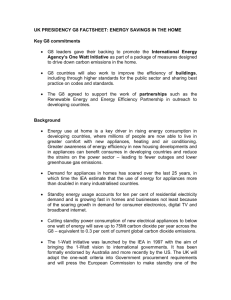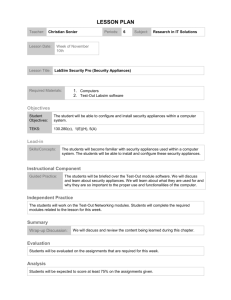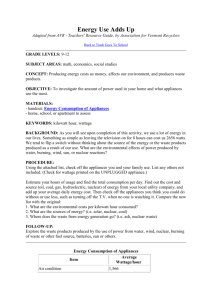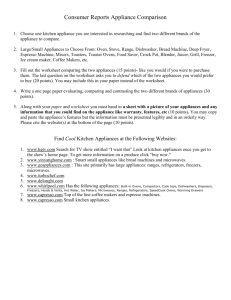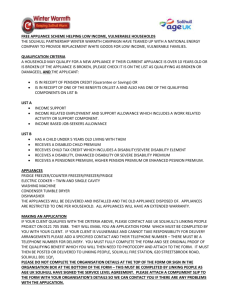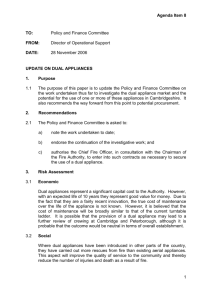Power Ratings (typical) for Common Appliances
advertisement
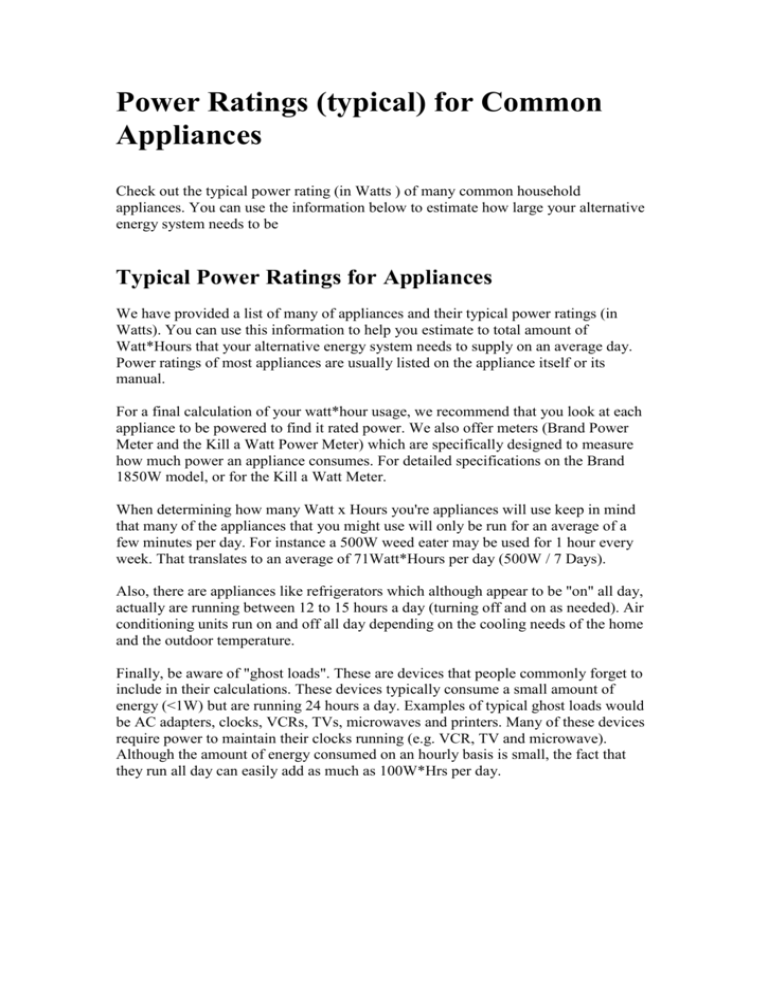
Power Ratings (typical) for Common Appliances Check out the typical power rating (in Watts ) of many common household appliances. You can use the information below to estimate how large your alternative energy system needs to be Typical Power Ratings for Appliances We have provided a list of many of appliances and their typical power ratings (in Watts). You can use this information to help you estimate to total amount of Watt*Hours that your alternative energy system needs to supply on an average day. Power ratings of most appliances are usually listed on the appliance itself or its manual. For a final calculation of your watt*hour usage, we recommend that you look at each appliance to be powered to find it rated power. We also offer meters (Brand Power Meter and the Kill a Watt Power Meter) which are specifically designed to measure how much power an appliance consumes. For detailed specifications on the Brand 1850W model, or for the Kill a Watt Meter. When determining how many Watt x Hours you're appliances will use keep in mind that many of the appliances that you might use will only be run for an average of a few minutes per day. For instance a 500W weed eater may be used for 1 hour every week. That translates to an average of 71Watt*Hours per day (500W / 7 Days). Also, there are appliances like refrigerators which although appear to be "on" all day, actually are running between 12 to 15 hours a day (turning off and on as needed). Air conditioning units run on and off all day depending on the cooling needs of the home and the outdoor temperature. Finally, be aware of "ghost loads". These are devices that people commonly forget to include in their calculations. These devices typically consume a small amount of energy (<1W) but are running 24 hours a day. Examples of typical ghost loads would be AC adapters, clocks, VCRs, TVs, microwaves and printers. Many of these devices require power to maintain their clocks running (e.g. VCR, TV and microwave). Although the amount of energy consumed on an hourly basis is small, the fact that they run all day can easily add as much as 100W*Hrs per day. Appliance Air Conditioner Watts Room* Central* Air Conditioners rated in tons For Each Ton Assume E.g. 5 Ton AC Unit Blender Blow Dryer CB Radio CD Player Ceiling Fan Computer Laptop Desktop PC Printer Coffee Maker Clock Radio Dishwasher Dryer (Clothes) Electric* Gas Heated Electric Blanket Electric Clock Frying Pan Freezer Conventional 14cf (15 hrs/day runtime) Sunfrost 19cf Freezer Furnace Blower Garage Door Opener Heater Engine Block* Portable* Waterbed* Stock Tank* Hot Plate Iron Lights Fluorescent/Incandescent Equivalents Incandescent 1000 2000 - 5000 3517 17585 300 1000 - 1500 5 15 - 30 10 - 50 20 - 75 80 - 200 100 800 1 1200 - 1500 4000 300-400 200 1 1200 445 112 300 - 1000 350 150 - 1000 1500 400 100 1200 1000 Fluorescent (or compact fluorescent lightbulb) 30W 20W 16W 11W 600 - 1500 250 100W 75W 60W 40W Microwave Popcorn Popper Radiotelephone Receive Transmit Refrigerator/Freezer Conventional 20 cubic feet (15hrs/day runtime typical) Conventional 16cf (15hrs/day) Sunfrost 16cf DC (7) Sunfrost 12cf DC (7) Conserve 10.5cf (8) Conserve 7.5cf (8) Satellite Dish Sewing Machine Shaver Sink Waste Disposal Stereo Table Fan Toaster Tools Weed Eater 1/4" drill 1/2" drill 1" drill 9" disc sander 3" belt sander 12" chain saw 14" band saw 7 1/4" circular saw 8 1/4" circular saw Vacuum Cleaner Upright Hand VCR Waffle Iron Washing Machine 5 40 - 150 540 475 112 70 60 50 30 100 15 450 10 - 30 10 - 25 800 - 1500 500 250 750 1000 1200 1000 1100 1100 900 1400 200 - 700 150 40 1200 500

